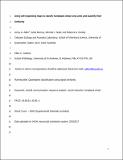Files in this item
Using self-organizing maps to classify humpback whale song units and quantify their similarity
Item metadata
| dc.contributor.author | Allen, Jenny A. | |
| dc.contributor.author | Murray, Anita | |
| dc.contributor.author | Noad, Michael J. | |
| dc.contributor.author | Dunlop, Rebecca A. | |
| dc.contributor.author | Garland, Ellen Clare | |
| dc.date.accessioned | 2018-04-10T23:33:23Z | |
| dc.date.available | 2018-04-10T23:33:23Z | |
| dc.date.issued | 2017-10-10 | |
| dc.identifier | 249711869 | |
| dc.identifier | 23c48721-dfaf-4525-88e9-4ac2d22e0631 | |
| dc.identifier | 85031302820 | |
| dc.identifier | 000413528900036 | |
| dc.identifier.citation | Allen , J A , Murray , A , Noad , M J , Dunlop , R A & Garland , E C 2017 , ' Using self-organizing maps to classify humpback whale song units and quantify their similarity ' , Journal of the Acoustical Society of America , vol. 142 , no. 4 , pp. 1943-1952 . https://doi.org/10.1121/1.4982040 | en |
| dc.identifier.issn | 0001-4966 | |
| dc.identifier.other | ORCID: /0000-0002-8240-1267/work/49580220 | |
| dc.identifier.uri | https://hdl.handle.net/10023/13109 | |
| dc.description | E.C.G. was funded by a Royal Society Newton International Fellowship. | en |
| dc.description.abstract | Classification of vocal signals can be undertaken using a wide variety of qualitative and quantitative techniques. Using east Australian humpback whale song from 2002-2014, a subset of vocal signals were acoustically measured and then classified using a self-organizing map (SOM). The SOM created 1) an acoustic dictionary of units representing the song’s repertoire, and 2) Cartesian distance measurements among all unit types (SOM nodes). Utilizing the SOM dictionary as a guide, additional song recordings from east Australia were rapidly (manually) transcribed. To assess the similarity in song sequences, the Cartesian distance output from the SOM was applied in Levenshtein distance similarity analyses as a weighting factor to better incorporate unit similarity in the calculation (previously a qualitative process). SOMs provide a more robust and repeatable means of categorizing acoustic signals along with a clear quantitative measurement of sound type similarity based on acoustic features. This method can be utilized for a wide variety of acoustic databases especially those containing very large datasets, and be applied across the vocalization research community to help address concerns surrounding inconsistency in manual classification. | |
| dc.format.extent | 1327613 | |
| dc.language.iso | eng | |
| dc.relation.ispartof | Journal of the Acoustical Society of America | en |
| dc.subject | Animal communication | en |
| dc.subject | Sequence analysis | en |
| dc.subject | Neural networks | en |
| dc.subject | Humpback whale | en |
| dc.subject | GC Oceanography | en |
| dc.subject | QA75 Electronic computers. Computer science | en |
| dc.subject | QH301 Biology | en |
| dc.subject | NDAS | en |
| dc.subject.lcc | GC | en |
| dc.subject.lcc | QA75 | en |
| dc.subject.lcc | QH301 | en |
| dc.title | Using self-organizing maps to classify humpback whale song units and quantify their similarity | en |
| dc.type | Journal article | en |
| dc.contributor.sponsor | The Royal Society | en |
| dc.contributor.institution | University of St Andrews. School of Biology | en |
| dc.contributor.institution | University of St Andrews. Sea Mammal Research Unit | en |
| dc.contributor.institution | University of St Andrews. Centre for Social Learning & Cognitive Evolution | en |
| dc.contributor.institution | University of St Andrews. Centre for Biological Diversity | en |
| dc.identifier.doi | https://doi.org/10.1121/1.4982040 | |
| dc.description.status | Peer reviewed | en |
| dc.date.embargoedUntil | 2018-04-10 | |
| dc.identifier.grantnumber | NF140667 | en |
This item appears in the following Collection(s)
Items in the St Andrews Research Repository are protected by copyright, with all rights reserved, unless otherwise indicated.

